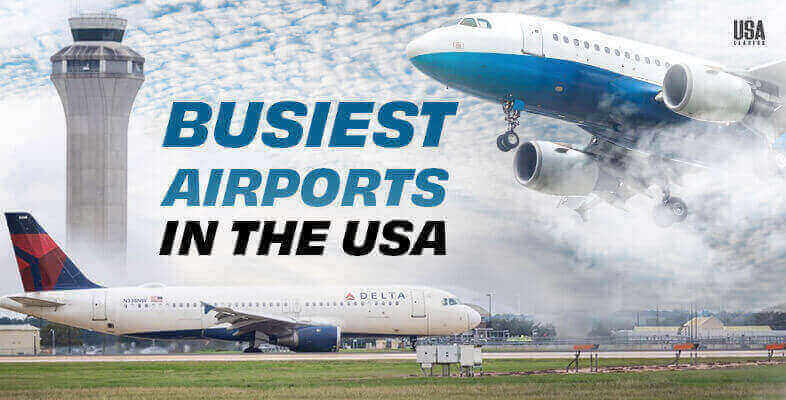Did you know that over 2.5 million passengers fly through U.S. airports every single day? That’s like moving the entire population of Houston—daily—through terminals, gates, and runways. The busiest airports in the USA aren’t just gateways for travelers; they’re strategic powerhouses shaping America’s airspace and economy. In this post, you’ll discover the top 10 busiest airports based on real-time airline seat data for 2025, offering the clearest view of where aviation demand is rising fastest. We’ve used verified reports from the Federal Aviation Administration (FAA) and Airports Council International (ACI) to ensure complete accuracy. But this list goes deeper than just numbers—it’s about understanding how these airports are built, why airlines prioritize them, and how they power jobs, trade, and infrastructure growth. If you’ve ever wondered how airport traffic reveals America’s economic pulse, you’re about to find out.
Why These Rankings Matter: Understanding the Data
When we look at the busiest airports in the USA, it’s not just about how many people fly. It’s about how airports are built, run, and chosen by airlines.
These rankings are based on the number of airline seats scheduled, not just passengers. That means we’re measuring capacity—how much travel each airport can handle, not just how many people walked through the doors. This tells us a lot about airport planning, airline demand, and future growth.
To keep things reliable, the data comes from real-time airline schedules and flight operations. These numbers are widely used by experts to study airport efficiency and airline strategies.
Now, why does this matter?
Because a seat isn’t just a seat.
It shows:
- How much demand an airport is handling.
- How airlines choose their main hubs.
- What level of service can travelers expect?
- Whether the airport is ready for tomorrow’s traffic.
Take Dallas or Denver, for example. A high seat count shows they aren’t just busy—they’re becoming powerhouses of connectivity.
So, when we track the busiest airports in the USA by seats, we’re seeing the full picture—network strength, airline decisions, and the traveler’s real-world experience.
Here are the 10 busiest airports in the USA
| Airport Name | Code | Departing Seats |
| Atlanta Hartsfield-Jackson | ATL | 38.0 million |
| Chicago O’Hare | ORD | 31.3 million |
| Dallas Fort Worth | DFW | 30.7 million |
| Denver International Airport | DEN | 29.73 million |
| Los Angeles International Airport | LAX | 27.07 million |
| New York John F. Kennedy International Airport | JFK | 23.56 million |
| Las Vegas Harry Reid International Airport | LAS | 20.28 million |
| Douglas International Airport | CLT | 20.06 million |
| San Francisco International Airport | SFO | 19.62 million |
| Seattle-Tacoma International Airport | SEA | 19.62 million |
1. Atlanta Hartsfield-Jackson
Ever wondered which airport tops the list of the busiest airports in the USA? It’s Atlanta’s Hartsfield-Jackson (ATL), and it’s not even close. This airport isn’t just the busiest in the U.S.—it’s the busiest in the entire world.
Here’s why ATL stands out in 2025:
Key Numbers You Should Know:
- Passenger Traffic: Around 108 million travelers flew through ATL between 2024 and 2025. That’s a rise from 104 million the previous year.
- Scheduled Seats: In July 2025 alone, ATL offered over 5.7 million airline seats—a 1% increase from last year.
- Summer Capacity: A total of 38 million seats are scheduled for summer, marking a 2% growth.
- Aircraft Movements: ATL handles more flights than any other airport in the world—proof of nonstop activity.
Why ATL Keeps Winning:
- It’s a major hub for both U.S. and international flights, linking passengers across the globe.
- Its location is central, making it ideal for layovers and connecting flights.
- Airlines keep adding more seats because demand keeps rising.
- The airport runs efficiently, even with record-breaking traffic.
What Makes ATL So Important?
Think of it this way: If airports were highways, ATL would be the busiest junction. And yet, it keeps traffic flowing.
As travel grows, Atlanta is expected to handle 125 million passengers a year soon. That kind of growth shows just how vital it is to the network of busiest airports in the USA—not just in size, but in how it connects people and powers the system.
2. Chicago O’Hare
Chicago O’Hare International Airport (ORD) is making headlines in 2025—and for all the right reasons. It’s not just busy; it’s booming. O’Hare is setting new records in both passenger traffic and flight capacity, earning its place among the top busiest airports in the USA.
What Makes O’Hare Stand Out in 2025?
- Record Day: On July 20, 2025, over 115,000 passengers passed through security in just one day.
- Summer Growth: Scheduled summer seat capacity reached 31.3 million, up 7% from 2024 and 4% over the 2019 peak.
- May 2025 Traffic: The airport saw around 8 million passengers, marking an 11.1% jump year-over-year.
Why Airlines Choose O’Hare:
- Strategic Hub: Both United and American Airlines call O’Hare a major base.
- Flight Growth: United increased domestic seats by 9%; American grew them by 20–25%.
- Central Location: O’Hare connects the country coast to coast and beyond.
Challenges & Solutions:
- Delays from weather and long security lines still occur.
- However, TSA upgrades and expanded CBP staffing are helping move things faster.
- Terminal 5 expansion and new gates (19 by 2028) will ease future pressure.
The Future Is Built In:
Chicago is investing billions into O’Hare. New terminals and added gate space mean 25% more room for flights and travelers.
O’Hare is more than just busy—it’s evolving fast. As one of the busiest airports in the USA, it’s staying future-ready while keeping people moving today.
3. Dallas-Fort Worth
Dallas/Fort Worth International Airport (DFW) is not just another busy airport. In 2025, it proudly ranks third globally for both passenger traffic and aircraft movements. This makes it one of the true giants among the busiest airports in the USA.
Key Highlights for 2025:
- Passenger Volume: DFW served 87.8 million passengers in 2024, up 7.4% from 2023.
- Aircraft Movements: With over 743,000 flights in 2024, DFW ranks third worldwide.
- Summer 2025 Seats: Offers 4.7 million seats, showing a slight dip but still holding strong.
Why DFW Holds Strategic Power:
- American Airlines’ Main Hub: DFW is American Airlines’ biggest base—second-largest single airline hub globally.
- Top Destination Coverage: Connects 269 destinations—more than any other airport in North America.
- Texas’ Busiest International Gateway: And eighth-busiest in the entire U.S.
DFW’s location between Dallas and Fort Worth helps it serve millions across the North Texas region. It offers both reach and convenience.
More Than Just Busy—It’s Smart:
- Sustainability Leader: DFW is the largest carbon-neutral airport in the world.
- Size and Space: Spans over 17,000 acres, with enough space for future growth.
- Passenger Growth: Traffic is up 17% since 2019, and the trend continues.
Even with a small dip in seats in 2025, DFW remains on a strong growth path. With continuous investments in infrastructure and sustainability, it secures its place among the most vital and future-ready busiest airports in the USA.
4. Denver International Airport
Denver International Airport (DEN) is quietly becoming a powerhouse. In 2025, it ranks as the third-busiest airport in the U.S. and sixth in the world. With consistent growth and long-term planning, Denver is no longer just central—it’s essential.
Strong Growth in Every Area:
- Passenger Volume: DEN served nearly 82.4 million people in 2024—a 5.8% increase over 2023.
- 2025 Target: The airport is on track to hit 85 million passengers this year.
- Aircraft Movements: Over 336,000 flights took off or landed in 2024—7% higher than in 2019.
Airline Hub Power:
- United Airlines leads with 39 million passengers—nearly half of all travelers at DEN.
- Southwest and Frontier also have major operations, making DEN a true three-airline hub.
- United has now made Denver its largest hub, even ahead of Chicago O’Hare.
Why Denver’s Growth Matters:
- Strategic Location: Near the Rockies and Great Plains, DEN connects 231 global destinations with ease.
- Economic Engine: The airport powers over 40,000 jobs and adds $47.2 billion to Colorado’s economy.
What’s Next for DEN?
- “Operation 2045” will add 100 new gates, targeting 125 million annual passengers.
- New A380 international routes and expanded terminals are already in progress.
- The airport also aims for carbon neutrality, leading U.S. airports in climate goals.
Among the busiest airports in the USA, Denver is one to watch. It blends massive growth with smart planning and a clear eye on the future.
5. Los Angeles International Airport
Los Angeles International Airport (LAX) remains one of the busiest airports in the USA in 2025. As the top West Coast hub, LAX continues to link millions of travelers across the world every year.
Strong Performance and Steady Growth
- In 2024, LAX served 76.6 million passengers, a 2% rise over the previous year.
- In June 2025, it handled 6.8 million flyers, with 2.2 million international travelers.
- The airport also recorded over 581,000 aircraft movements last year, keeping pace with global flight operations.
Key Airline Market Share (Jan–May 2025):
- Delta: 19.48%
- United: 15.49%
- American: 15.21%
- Southwest: 8.18%
- Alaska: 7.18%
Why LAX Still Matters
- It’s the largest international airport on the U.S. West Coast.
- LAX ranks 8th globally by passenger volume and second in the U.S. for international traffic, right after JFK.
- With 150+ international flights daily, it connects travelers to over 60 countries.
Major Routes in 2025
- Domestic: New York-JFK, Chicago-O’Hare, San Francisco, Las Vegas, Honolulu
- International: London-Heathrow, Seoul-Incheon, Tokyo-Haneda, Taipei, Guadalajara
Forward-Thinking Infrastructure
- Ongoing terminal upgrades aim to ease congestion and speed up security.
- More gates and modern systems will help LAX manage growing demand.
In short, LAX plays a critical role in connecting the U.S. to the world. With rising traffic, diverse airline partnerships, and continuous upgrades, it remains a key player among the busiest airports in the USA.
Beyond the Tarmac: The Economic Engine of America
When we think about the busiest airports in the USA, we often picture packed terminals and endless queues. But beneath all that movement lies an even bigger story—one about economic powerhouses that keep cities and industries alive. These airports support tens of thousands of jobs, from pilots and air traffic controllers to TSA agents, baggage handlers, retail staff, and fuel technicians. Every plane that takes off or lands sets off a chain reaction of economic activity, involving hundreds of people behind the scenes.
They don’t just connect cities—they power them. Take Denver International Airport as an example. As passenger numbers have grown, so has the surrounding economy—hotels, restaurants, startups, and real estate have all benefited. Airports like LAX and O’Hare are also vital for global trade, moving high-value cargo like electronics and medicine in a matter of hours. In many cases, businesses depend on these fast deliveries to meet demand and stay competitive.
At the same time, airlines continue to pour billions into airport infrastructure—building new terminals, expanding runways, upgrading lounges, and fueling innovation. This investment creates more jobs in construction, engineering, and local services. The ripple effect is massive, spreading across entire metro regions. So, while airports may be measured by their passenger seats, their real influence goes far beyond. They’re economic engines, quietly powering the country with every takeoff and landing.
Key Takeaways
I’ve always found that airport rankings—when measured by airline seats—tell a deeper story than just passenger counts. They quietly map out the pulse of American air travel, revealing where people are going, how airlines are thinking, and which cities are evolving into major aviation hubs. It’s not just about being big; it’s about being connected, efficient, and future-ready.
Why do some airports consistently dominate while others surge out of nowhere? The answer lies in strategy. It’s about route networks, airline partnerships, terminal capacity, and how well the airport adapts to shifting travel patterns. When seats go up, it signals more than demand—it suggests confidence, investment, and long-term vision.
This list also shows that size doesn’t always equal importance. Some rising airports are winning not through legacy status, but through innovation, logistics, and regional influence. And that’s what makes this trend worth tracking.
As the U.S. reshapes how it flies, these airports aren’t just gateways—they’re growth engines. They reflect not only the present but also hint at what the next decade of American mobility might look like. And in that future, every added seat could be a building block toward smarter, faster, and more connected travel.




















